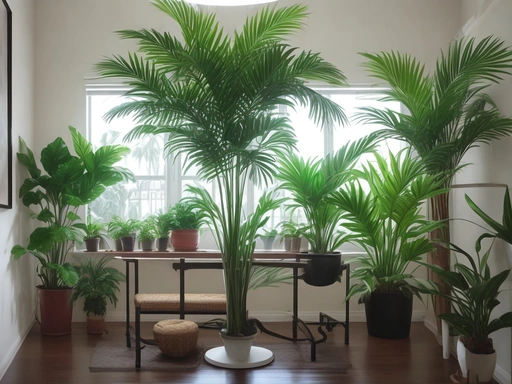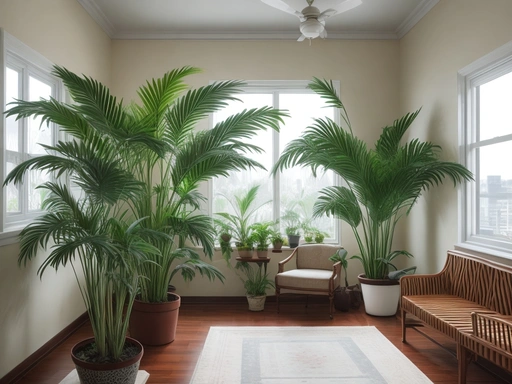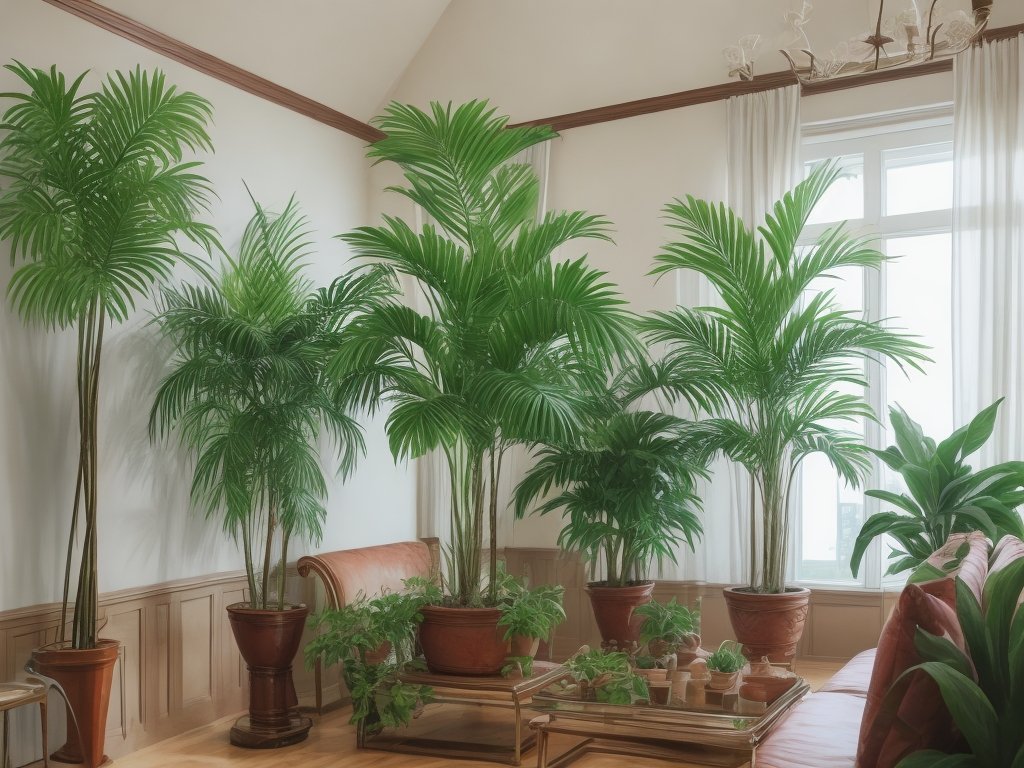Parlor Palm And NASA’s Clean Air Study: Nature’s Air Purifier
Key Takeaways:
- Parlor palms are effective in removing indoor air pollutants, according to NASA’s clean air study.
- They can help improve air quality by eliminating common household toxins like formaldehyde and benzene.
- Parlor palms are low-maintenance plants that are perfect for indoor spaces.
- These plants can also enhance humidity levels, making them beneficial for dry environments.
Are you looking to enhance the air quality in your home while adding some greenery to your space? Look no further than the Parlor Palm.
This popular houseplant not only adds beauty to any room but also has the incredible ability to purify the air.
In fact, it has been studied by none other than NASA in their Clean Air Study. In this blog, I will delve into the characteristics of the Parlor Palm, its air purification abilities, and share some tips on how to care for this fantastic plant.
Stay tuned for some fascinating insights into improving your indoor air quality with the help of the Parlor Palm.
| Topic | Parlor Palm and NASA’s Clean Air Study |
| Category | Plants and Air Quality |
| Introduction | Parlor palm (Chamaedorea elegans) is a popular houseplant known for its aesthetic appeal and low maintenance requirements. In addition to being visually appealing, the parlor palm has been studied by NASA for its air purifying qualities. |
| NASA’s Clean Air Study | NASA conducted a study in 1989 to identify indoor plants that can improve indoor air quality. Parlor palm was one of the plants included in the study and was found to be effective in removing certain airborne toxins. |
| Air Purifying Qualities | The parlor palm is known to effectively remove toxins such as formaldehyde, benzene, and carbon monoxide from the air. These toxins can be present in indoor environments due to the use of certain household products and poor ventilation. |
| Benefits | Adding a parlor palm to indoor spaces can not only enhance the aesthetic appeal but also contribute to cleaner and healthier air quality. Cleaner air can have positive effects on overall well-being and reduce the risk of respiratory issues. |
The Parlor Palm: A Popular Houseplant
The Parlor Palm is a beloved and widely popular houseplant. It adds a touch of greenery and elegance to any indoor space.
Description and Characteristics of the Parlor Palm
The Parlor Palm, also known as Chamaedorea elegans, is a popular houseplant cherished for its elegant appearance and adaptability.
It features feathery, arching fronds that give it a tropical vibe.
The plant can reach a height of 2-6 feet and has a slender, bamboo-like stem.
Parlor Palms are easy to care for and can thrive in low light conditions, making them a perfect choice for indoor spaces.
They are also non-toxic to pets, making them safe to have around furry friends.
Benefits of Having Parlor Palm Houseplants
The benefits of having Parlor Palm Houseplants are numerous. They not only enhance the aesthetic appeal of your indoor space but also contribute to improving indoor air quality.
Parlor Palms remove harmful toxins from the air, such as formaldehyde and benzene, and release oxygen, creating a healthier breathing environment.
They also act as natural humidifiers, adding moisture to the air, which can be beneficial for those suffering from dry skin or respiratory issues. Additionally, Parlor Palms are known for their low maintenance requirements, making them a popular choice for busy individuals or those with a limited green thumb.
Overall, having Parlor Palm Houseplants is a simple and effective way to bring beauty and health benefits into your home or office environment.
Caring for the Parlor Palm
To care for your Parlor Palm, place it in a bright, indirect light location. Water it when the top inch of soil feels dry, ensuring not to overwater it.
Maintain humidity by misting or placing a tray of water nearby.
Prune any yellow or brown leaves and repot as needed.
NASA’s Clean Air Study
NASA conducted a Clean Air Study to determine which plants are best at purifying the air indoors.
They found that certain houseplants, including the Parlor Palm, can effectively remove toxins and improve air quality.
This study has led to increased interest in using plants to enhance indoor air quality and promote a healthier living environment.
Parlor Palm: An Ideal Plant for Improving Air Quality
The Parlor Palm is a perfect choice if you’re looking to improve the air quality in your home or office.
NASA’s Clean Air Study
NASA’s Clean Air Study is a research project by NASA that aimed to find ways to improve indoor air quality. They discovered that certain plants, including the Parlor Palm, can effectively remove toxins from the air.
These plants can help reduce indoor air pollution and create a healthier living environment.

How Plants Improve Indoor Air Quality
Plants improve indoor air quality by filtering out harmful pollutants and releasing oxygen. They absorb carbon dioxide and volatile organic compounds (VOCs), which are produced by furniture, cleaning products, and other household items.
In return, plants release moisture, making the air more humid.
This helps reduce respiratory issues and improves overall well-being. Some plants, like the Parlor Palm, are particularly effective at purifying the air.

The Parlor Palm and Its Air Purification Abilities
The Parlor Palm is known for its air purification abilities. It can effectively remove harmful indoor toxins such as formaldehyde, benzene, and carbon monoxide.
It releases oxygen and helps humidify the air, making it healthier to breathe.
Keeping a Parlor Palm in your home can improve indoor air quality and create a healthier living environment.

Other Houseplants Studied by NASA for Clean Air
NASA’s Clean Air Study identified several other houseplants that can improve indoor air quality. Some of these plants include:
- Snake Plant (Sansevieria
- Spider Plant (Chlorophytum comosum
- Aloe Vera (Aloe barbadensis
- Boston Fern (Nephrolepis exaltata
- Peace Lily (Spathiphyllum
These plants were found to be effective in removing common indoor air pollutants such as formaldehyde, benzene, and xylene. Incorporating these houseplants into your living space can help create a healthier environment.
Tips for Growing Parlor Palms in Your Home
Want to successfully grow parlor palms in your home? Here are some useful tips!
Best Locations for Parlor Palms
Parlor palms thrive best in bright, indirect light. Place them near north or east-facing windows where they can get plenty of filtered sunlight.
Avoid placing them in direct sunlight, as it can scorch their delicate leaves.
They also do well in low-light conditions, making them suitable for offices or rooms with less natural light. Just ensure they still receive some indirect light throughout the day.
Ideal Growing Conditions for Parlor Palms
The ideal growing conditions for Parlor Palms include indirect sunlight, moderate temperatures between 60-80°F (15-26°C), and high humidity levels. They prefer well-draining soil and should be watered when the top inch of soil feels dry.
Avoid placing them near drafts or in extremely cold or hot environments.
Watering and Humidity Tips for Parlor Palms
Water your Parlor Palm thoroughly when the top inch of soil feels dry, but avoid over-watering. Ensure good drainage to prevent root rot.
Mist the leaves regularly to increase humidity, or place the plant on a tray filled with water and pebbles.
Avoid placing the plant near air conditioning or heating vents as it can dry out the air.
Pruning and Repotting Your Parlor Palm
To keep your Parlor Palm healthy and thriving, it’s important to prune and repot it when necessary. Here’s what you need to know:
- Pruning: Remove any yellow or brown leaves by cutting them off at the base of the stem. This will help maintain the plant’s appearance and prevent the spread of disease.
- Repotting: When your Parlor Palm outgrows its current pot, it’s time to repot. Choose a new pot that is one size larger and fill it with fresh, well-draining potting mix. Carefully transfer the plant, ensuring the roots are spread out evenly.
- Frequency: Pruning can be done as needed throughout the year, while repotting should only be done every 2-3 years or when the roots have become overcrowded.
- Careful Handling: When pruning or repotting, be gentle with your Parlor Palm to avoid damaging the delicate leaves and roots.
Remember, by taking the time to properly prune and repot your Parlor Palm, you’ll be helping it thrive and stay healthy in your home.
Frequently Asked Questions about Parlor Palms and NASA’s Clean Air Study
What other plants can improve indoor air quality?
Other plants that can improve indoor air quality include the Snake Plant, Spider Plant, Aloe Vera, Peace Lily, and English Ivy. These plants are known for their ability to remove toxins and pollutants from the air, making your indoor environment healthier and fresher.
Can the Parlor Palm survive in low-light conditions?
Yes, the Parlor Palm can survive in low-light conditions.
It is known for its adaptability and can thrive in areas with minimal natural light.
However, it is important to note that while the Parlor Palm can tolerate low-light environments, it still needs some indirect sunlight to stay healthy.
So, placing it near a window or providing artificial light will help maintain its growth and overall well-being.
How often should I water my Parlor Palm?
Water your Parlor Palm thoroughly once the top inch of soil feels dry to the touch. This typically means watering every 1-2 weeks, depending on your home’s temperature and humidity levels.
Be sure not to overwater, as this can lead to root rot.
Always check the soil moisture before watering to prevent over or underwatering.
Can I use Parlor Palms in my office to improve air quality?
Yes, you can definitely use Parlor Palms in your office to improve air quality. Parlor Palms are known for their ability to remove toxins from the air and release oxygen.
They can help filter out pollutants like formaldehyde, benzene, and xylene, which can be found in office furniture, carpets, and cleaning products.
Just make sure to place your Parlor Palm in a well-lit area and water it regularly to keep it healthy and thriving.
Are there any harmful effects of Parlor Palms on pets?
No, Parlor Palms are not harmful to pets.
They are non-toxic and safe for cats, dogs, and other animals.
However, it’s always a good idea to prevent pets from chewing or ingesting any houseplants, including Parlor Palms, to avoid any potential digestive issues.
Keeping the plants out of your pet’s reach is the best way to ensure their safety.
Final Verdict
The Parlor Palm is a popular houseplant that not only adds beauty to your home but also can improve indoor air quality.
NASA’s Clean Air Study has shown that the Parlor Palm, along with other houseplants, can effectively remove harmful toxins from the air, making it a valuable addition to any space.
By following the tips provided for caring for Parlor Palms, you can ensure their optimal growth and air-purifying capabilities.
Whether it’s in your home or office, incorporating Parlor Palms can have a positive impact on your environment and your health.
So, why not bring this green companion into your space and breathe cleaner air?






